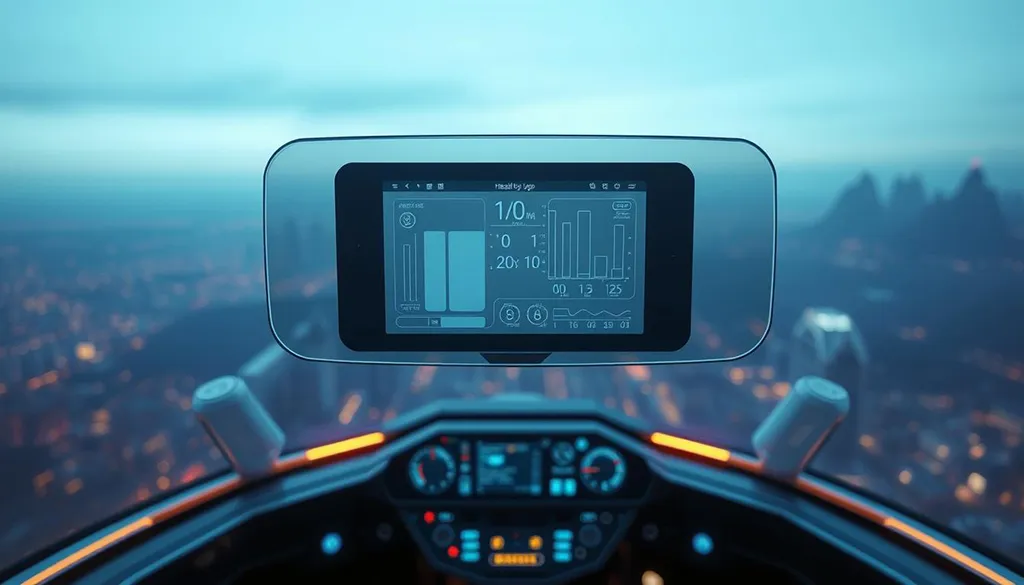A heads up display (HUD) is changing how we use our vehicles. It shows important info on a clear surface, like the windshield. This keeps key data in the driver’s sight, making driving safer and more efficient.
Drivers can see their speed and directions without looking away. This article will explore HUD’s features and history. We’ll also look at the top HUD models available today. By understanding HUD technology, we see how it makes driving safer and more convenient.
Key Takeaways
- Heads up displays project vital driving information onto windshields, reducing distractions.
- Modern HUDs showcase metrics like speed, navigation, fuel levels, and safety alerts.
- Innovation in HUD technology traces back to the 1950s, initially developed for military aviation.
- Chevrolet offers several models equipped with HUD technology, enriching the driver’s experience.
- Adjustable HUD settings cater to individual driver preferences for optimal visibility.
Understanding Heads Up Display Technology
Heads up display technology has changed how drivers get information, making driving safer and more efficient. Nissan introduced it in 1989 for the 240SX and Maximas. Now, almost all luxury car makers offer it, like General Motors, Mercedes-Benz, and BMW.
This tech shows important info like speed and directions right in the driver’s line of sight. It lets drivers check vital data quickly, keeping them focused on the road.
>> Read more:
- Dash cam for car: Best choose 2025

Understanding Heads Up Display Technology
Today’s HUD systems can show lots of useful info, making driving better. Each HUD needs to be set up just right to work well. If it’s not, it can cause problems and distract the driver. New tech, like automated calibration, is being worked on to fix this.
The future of HUD tech looks bright, with more safety and convenience features. Things like augmented reality (AR) will make navigation and awareness even better. As car makers listen to what people want, HUDs are becoming more common. This shows a big push towards making driving safer and more comfortable.
| Manufacturer | Year Introduced | Key Features |
| Nissan | 1989 | First mass-market HUD |
| General Motors | 1980s | Classic HUD integration |
| Mercedes-Benz | 2000s | High-resolution display |
| BMW | 2000s | Augmented Reality options |
| Toyota | 2010s | Comprehensive driver alerts |
What is a Heads Up Display?
A heads up display (HUD) is a cutting-edge technology that changes how drivers get important info while driving. It’s key for car lovers and those who care about safety. It shows vital data on the windshield, cutting down on distractions and making driving better.
Definition and Overview
The HUD definition is about a clear display that shows things like speed, directions, and alerts right in the driver’s sight. It started in the military and came to cars in the 1980s, with the 1988 Oldsmobile Cutlass Supreme being the first.
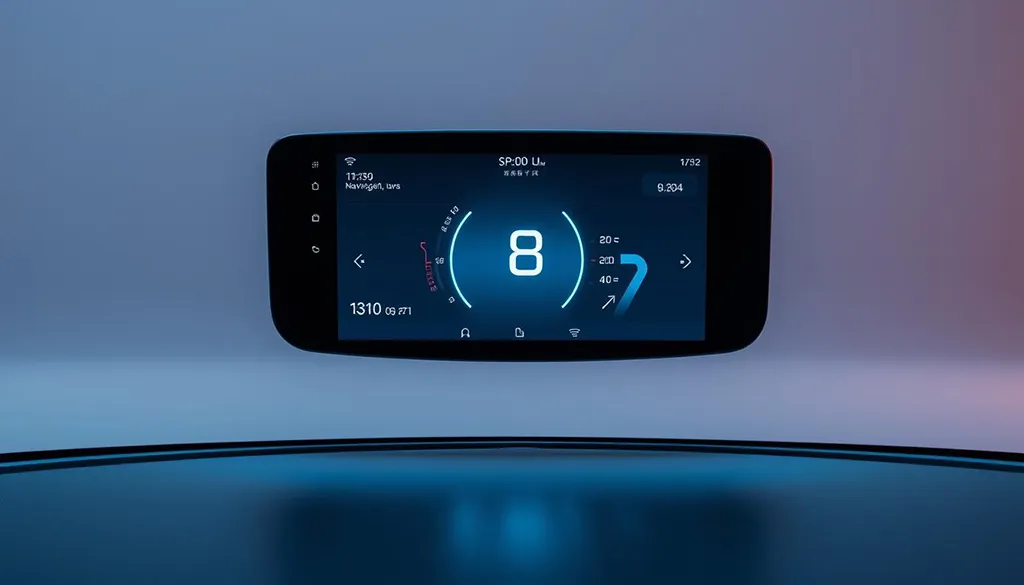
What is a Heads Up Display?
At first, only luxury cars had HUDs. But now, cars like the Vauxhall Astra and Ford Focus have them too, showing how common it’s becoming.
How It Works
To get the most out of HUDs, it’s important to know how they work. They connect with the car’s sensors to show info like speed limits and directions on the windshield. Some HUDs even use augmented reality to show things like arrows for directions, making driving easier.
| Vehicle Model | Year Released | HUD Features |
| Oldsmobile Cutlass Supreme | 1988 | First vehicle with HUD technology |
| Ford Focus | 2019 | Projects onto a small screen from the dashboard |
| Vauxhall Astra | 2021 | Projects directly onto the windscreen, available in Ultimate trim |
| BMW 5 Series | Various | Part of a premium Technology Package |
| Volkswagen Golf | Various | Available as an optional feature with additional cost |
Key Features of Heads Up Displays
Heads up displays (HUDs) make driving better by showing important info. They help drivers stay alert and focused. HUDs use different tech to show info in ways that fit each driver’s needs.
Adjusting brightness and where the info shows up makes HUDs easier to use. This is true whether it’s bright outside or dark.
Information Displayed on HUDs
HUDs show key info like speed and navigation. Basic HUDs like WOLED just show simple images. But, more advanced HUDs, like AR-HUDs, show more info like lane warnings and navigation.
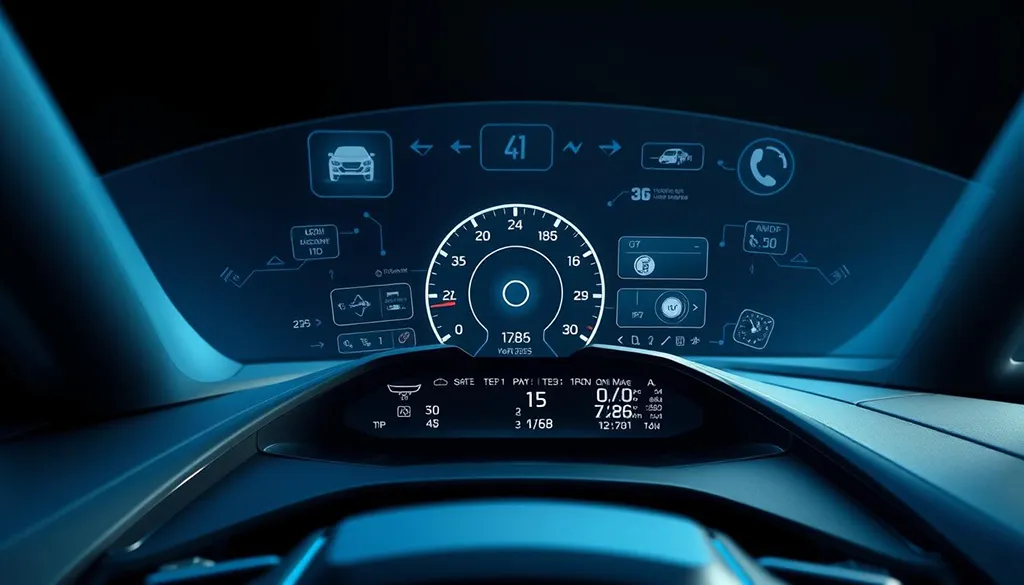
Key Features of Heads Up Displays
This extra info helps drivers stay aware and focused. It makes driving safer by reducing distractions.
Projection Technologies
There are different HUD techs, each with its own benefits. WOLED is simple but has limited color and detail. It’s found in cars like the Toyota Camry and Chevrolet Malibu.
AR-HUD, on the other hand, offers sharper images and more colors. It’s found in high-end cars like the Mercedes-Benz S-Class and BMW iX Flow. These HUDs show how advanced tech can improve driving.
Adjustable Brightness and Positioning
Most HUDs let you adjust brightness. This is key for seeing info clearly in different lights. You can also change where the info shows up.
This makes it easy to see without taking your eyes off the road. It’s all about making driving safer and more comfortable.
| Technology Type | Image Quality | Information Range | Example Vehicles |
| WOLED | Limited resolution, simpler colors | Basic data (speed, navigation) | Toyota Camry, Chevrolet Malibu |
| AR-HUD | High resolution, wider color gamut | Advanced data (lane guidance, object detection) | Mercedes-Benz S-Class, BMW iX Flow |
Advantages of Using a Heads Up Display
Heads up display (HUD) technology in cars offers many benefits. It makes driving safer and more aware. Here are the main advantages of using a heads up display while driving.
Improved Driving Safety
Heads up displays make driving safer. They show important info right in the driver’s sight, so they don’t have to look away. Studies show HUDs can cut accident risks by up to 30%.
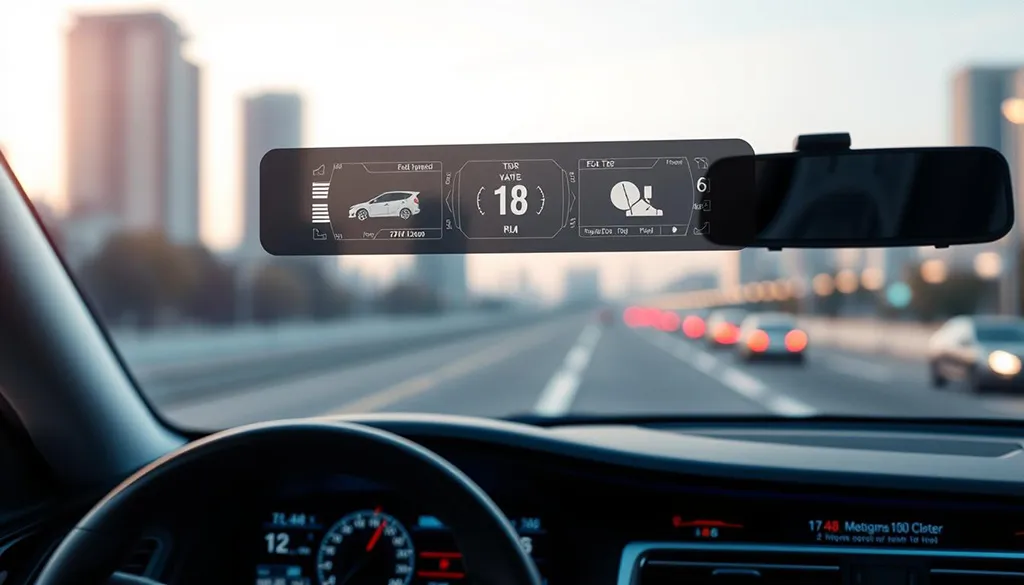
Advantages of Using a Heads Up Display
They help drivers keep an eye on speed and directions without looking away. This makes them a great addition to any car.
Enhanced Situational Awareness
Heads up displays also improve situational awareness. They give real-time updates on traffic and directions, helping drivers make quick decisions. Drivers using HUDs stay 15% more aware than those without them.
This helps drivers spot dangers while keeping their eyes on the road.
Convenience and Efficiency
Heads up displays make driving more convenient. They show key performance stats right above the steering wheel. This makes driving smoother and safer.
Research shows HUDs with voice commands can save up to 25% of time. This lets drivers focus on safety without losing efficiency.
Night Driving Aids
Night driving can be tough, but HUDs help. They have adjustable brightness for better visibility in the dark. HUDs stay clear in bright light, too, with over 90% visibility.
This makes night driving safer and more comfortable. Drivers can enjoy a safer and more relaxed journey at night.
Best Heads Up Display Models on the Market
The market for heads up displays (HUDs) is growing fast. This is thanks to new tech and the need for safer driving. We’ll look at the top HUD models, their best features, and compare them.

Best Heads Up Display Models on the Market
Features of Top Models
When picking the best HUDs, some features really stand out:
- Augmented Reality Integration: High-end HUDs from Mercedes-Benz and BMW use AR. They show navigation cues on the road, making driving safer and easier.
- Comprehensive Information Display: The best HUDs show important info like speed, navigation, and vehicle health right in your sight.
- Adaptive Brightness: These HUDs are clear in any light, so you can see them day or night.
- Wide Field of View: HUDs projected on the windshield give a bigger view than combiner HUDs. This is common in bigger cars.
- Robust Connectivity: They work well with car systems through OBDII, Bluetooth, or GPS. This means you get real-time data and better performance.
Comparison of Leading Brands
Here’s a look at some top HUD brands and what they offer:
| Brand | Model | Type | Key Features | Price Range |
| BMW | iDrive HUD | Windshield | AR Navigation, Dynamic Info | Premium |
| Garmin | Head-Up Display | Combiner | GPS Integration, Speed Display | Mid-range |
| Mercedes-Benz | Augmented Reality HUD | Windshield | Real-time Directions, Lane Highlighting | Premium |
| Hudly | HD Display | Combiner | High Definition, User-friendly | Affordable |
| Timprove | Basic HUD | Combiner | Speed and Fuel Monitoring | Budget-friendly |
This comparison shows the wide range of HUDs out there. Each one meets different needs and budgets. Getting a HUD can make driving better and safer for everyone.
Heads Up Display in Popular Car Brands
Technology keeps getting better, and car makers are adding heads-up displays to their vehicles. This makes driving safer and more fun. Brands like Kia, BMW, Audi, and Mercedes-Benz are at the forefront. They each bring their own twist to HUD technology, making their cars stand out.
Kia Models with HUDs
Kia is really getting into heads-up displays. The Kia EV6 has an AR HUD in its higher trims. It shows important info right on the windshield, keeping drivers focused on the road.
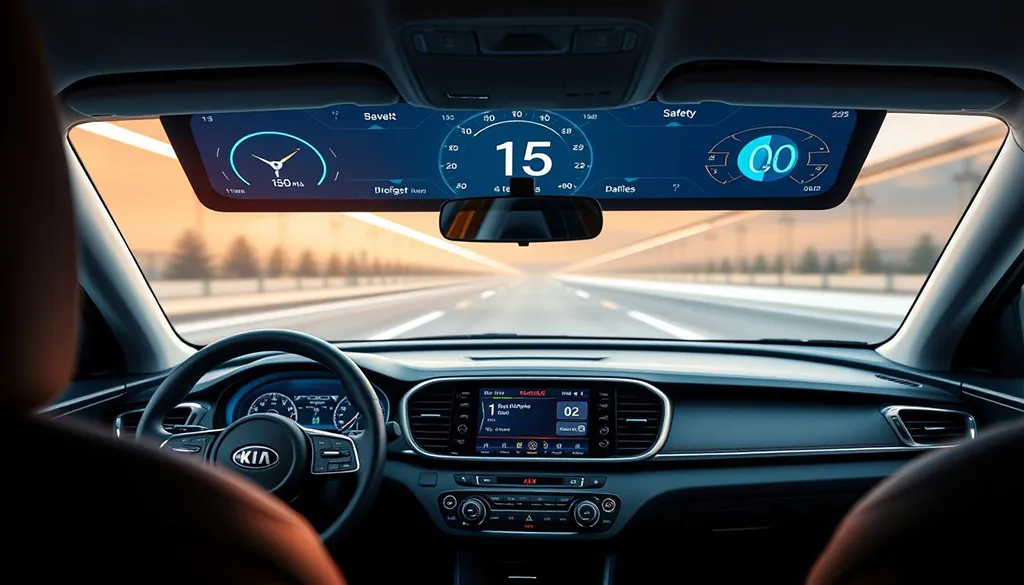
Heads Up Display in Popular Car Brands
The Kia Telluride also impresses with its design and safety features. It makes driving a pleasure while keeping you safe.
BMW and Audi’s Innovations
BMW has been leading in HUD tech for over 20 years. Their HUDs show things like navigation and speed right in your line of sight. Audi, on the other hand, is known for its clear and detailed HUDs.
Their cars offer a safe and engaging driving experience. This makes driving both safer and more enjoyable.
Mercedes-Benz Augmented Reality Heads Up Display
Mercedes-Benz is pushing HUD tech even further with augmented reality. Their HUDs give you an immersive experience, showing you important info in a way that makes you more aware of your surroundings.
These luxury cars set a high bar for HUD technology. They show how important it is to make driving better and safer.
These car makers are really pushing the limits of HUD technology. As more people want cars with HUDs, Kia, BMW, Audi, and Mercedes-Benz are leading the charge. They’re making driving safer and more enjoyable for everyone.
Historical Evolution of Heads Up Displays
The story of heads up displays, or HUDs, is a tale of technology’s growth and flexibility. It started in the military, aiming to reduce distractions for pilots. Now, HUDs are in cars, changing to meet our needs and likes.
From Military Applications to Automotive Use
In the 1940s, HUDs first appeared for U.S. military pilots in World War II. They showed flight data without pilots looking away. Over time, HUDs became common in cars, starting with luxury brands like Oldsmobile.

Historical Evolution of Heads Up Displays
The Oldsmobile Cutlass Supreme of 1988 was the first car with HUD. It showed speed and turn signals to drivers.
Technological Advancements Over the Years
HUD technology has grown a lot, meeting our needs and improving safety. Early HUDs showed simple info, but now they have lots of features. They show GPS, media info, and more, making driving better.
Today, HUDs are about 5 inches wide and 3 inches tall. They’re getting even better, with augmented reality and 3D projections. Companies like Falcon AR and WayRay are leading this progress, making HUDs exciting for the future.
| Year | Event | Technology Type |
| 1940s | Development of HUD for military pilots | Military Aviation |
| 1988 | First production car with HUD: Oldsmobile Cutlass Supreme | Automotive |
| 1999 | HUD featuring night vision assistants: Cadillac DeVille | Automotive |
| 2010s | Integration of HUDs into various aircraft, like the Boeing 787 | Aviation |
| Future | Augmented reality HUDs and 3D projections | Automotive |
Combiner vs. Windshield-Projected Heads Up Displays
As car tech gets better, knowing the difference between combiner and windshield-projected HUDs is key. These HUDs differ in design, function, and price. It’s important to look at what each offers.
Combiner HUDs show data on a screen above the dashboard. Windshield-projected HUDs, on the other hand, show info right on the windshield. This makes them more integrated.
Comparison of Types
Windshield-projected HUDs are seen as the top choice. They offer a better driving experience with clear images. They show important info like navigation and speed limits right in your sight.
Combiner systems are cheaper but might have some issues. They can have alignment problems and show less info because of their smaller size.
Pros and Cons of Each Type
Windshield-projected HUDs are often preferred for their better user experience and wider view. Studies show they help drivers react faster and stay focused. They reduce eye movement.
Combiner HUDs are more affordable. They’re great for those watching their budget. As HUD tech improves, many might choose windshield models for their advanced features. Others might like the simplicity of combiner displays.
FAQ
What is a heads up display (HUD) in vehicles?
A heads up display (HUD) shows important driving info on the windshield. It lets me see speed and directions without looking away from the road.
How does a heads up display improve driving safety?
HUDs keep key info in my sight, reducing distractions. They show alerts and directions right on the windshield. This helps me react faster without taking my eyes off the road.
What types of information are displayed on heads up displays?
HUDs show important stuff like speed, directions, and safety alerts. It keeps me updated on my driving in a handy way.
What are the differences between combiner and windshield-projected HUDs?
Combiner HUDs have a small screen above the dashboard. They’re simpler and cheaper. Windshield-projected HUDs blend with the view, showing info directly on the windshield.

